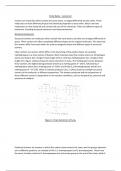Essay
Unit 14 Aim C: Isomerism Assignment (DISTINCTION)
- Vak
- Instelling
This is my distinction grade assignment for unit 14 aim C on different types of isomers. All criteria were met and I was awarded distinction. If you have any questions or concerns, please do not hesitate to get in touch. I hope you find my assignment helpful!
[Meer zien]




